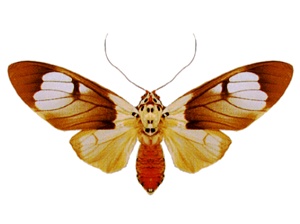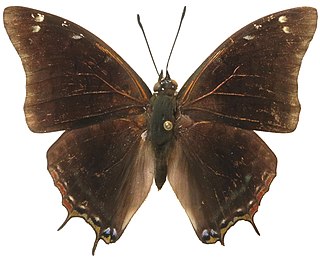
Lycaenidae is the second-largest family of butterflies, with over 6,000 species worldwide, whose members are also called gossamer-winged butterflies. They constitute about 30% of the known butterfly species.

The Arctiini are a tribe of tiger moths in the family Erebidae.

Miletinae is a subfamily of the family Lycaenidae of butterflies, commonly called harvesters and woolly legs, and virtually unique among butterflies in having predatory larvae. Miletinae are entirely aphytophagous. The ecology of the Miletinae is little understood, but adults and larvae live in association with ants, and most known species feed on Hemiptera, though some, like Liphyra, feed on the ants themselves. The butterflies, ants, and hemipterans, in some cases, seem to have complex symbiotic relationships benefiting all.

Amerila is a genus of moths in the subfamily Arctiinae. A number of species in this genus have a special defence mechanism when they are in their adult stage. When disturbed, they exude a frothy yellow fluid from glands beside the eyes, while making a sizzling noise to ward off their attacker. Similar behaviour has been observed in fertilised females of the North-American moth Utetheisa ornatrix.
Epilacydes is a genus of tiger moths in the family Erebidae erected by Arthur Gardiner Butler in 1875. The moths are found in the Afrotropics.

Chlidanotinae is a subfamily of moths in the family Tortricidae.
Robert Herbert Carcasson was an English entomologist who specialised in butterflies, but also authored two field guides to tropical fishes. He joined the Coryndon Museum, Nairobi, as senior entomologist in 1956. He then became its director, under the museum's new name of the Natural History Museum from 1961 to 1968. During this time he was awarded a PhD for his studies on African hawkmoths. From 1969 to 1971 he was Chief Curator of the Centennial Museum, Vancouver, Canada. In 1972 he travelled in Polynesia, Melanesia, Australia, Malaysia, Sri Lanka, Seychelles and East Africa for production of two field guides to coral reef fish of the Indo-Pacific region. From 1973 to 1979 he was Curator of Entomology at the Museum of British Columbia. He died of cancer. Somewhat a polymath, he was fluent in a number of languages, and produced the illustrations to a number of his works, culminating in hundreds of colour and line drawings of fishes for his reef fish field guides.

Utetheisa pulchella, the crimson-speckled flunkey, crimson-speckled footman, or crimson-speckled moth, is a moth of the family Erebidae. The species was first described by Carl Linnaeus in his 1758 10th edition of Systema Naturae.
Leucaloa is a genus of tiger moths in the family Erebidae. The moths in the genus are found in the Afrotropics.
Teracotona is a genus of moths in the family Erebidae from the Afrotropics. The genus was erected by Arthur Gardiner Butler in 1878.

Hypena lividalis is a moth of the family Erebidae. It has an Afrotropical and possibly Circumtropical distribution. It is known from the western parts of the Palearctic realm and the Neotropical realm. It is a rare migrant in western, central and northern Europe. In the Mediterranean sclerophyllous forest zone it is widespread and often abundant. In the Levant it has been recorded from Lebanon, Jordan, and Israel.
Udeoides is a genus of snout moths of the subfamily Spilomelinae in the family Crambidae. The genus was described by Koen Maes in 2006 and distinguished from the related genus Udea. All six species are distributed in the Afrotropical realm.

The Nyctemerina are a subtribe of woolly bear moths in the family Erebidae.
Eyralpenus meinhofi is a polymorphic tiger-moth in the family Erebidae first described by Max Bartel in 1903. It is known from the east and central Africa: Tanzania, Zambia, Zambia, Angola, Zaire ; Malawi ; Zaire ; Zimbabwe.
Madagascarctia is a genus of moths in the subfamily Arctiinae from Madagascar. The genus was erected by Vladimir Viktorovitch Dubatolov in 2006. As per David T. Goodger and Allan Watson (1995) the species of this genus have whitish wings speckled with brown.
Pericaliella is a genus of moths in the subfamily Arctiinae that is known from the Afrotropics. It includes one species Pericaliella melanodisca from Cameroon, Zaire, Uganda and Rwanda.
Popoudina is a genus of moths in the family Erebidae from the Afrotropics. The genus was erected by Vladimir Viktorovitch Dubatolov in 2006. Formerly, species of this genus were mistakenly included in Estigmene. Probably, some species of the latter genus might belong to Popoudina.
Radiarctia is a genus of moths in the family Erebidae from Afrotropics.

Charaxes variata is a butterfly in the family Nymphalidae. It is found in central, southern and north-western and western Zambia. The habitat consists of Cryptosepalum forests.
The Metarbelidae are a family of the Cossoidea also called the carpenter or goat moths, and is sometimes treated as a subfamily, Metarbelinae of the Cossidae. No synapomorphies are shared with the Cossidae based on adult morphology. The family Metarbelidae was first described by Embrik Strand in 1909.








